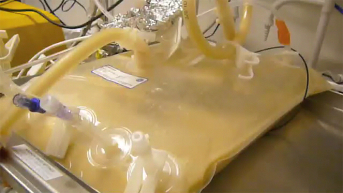Bioprocess Design
The development of new tools for high performance bioprocesses is always of fundamental interest for taking interesting and important products from the laboratory to public use.

In order to reach this far, processes must be economic and safe. The development is thus aimed for a high productivity, a high yield but also a high product quality. The target of our research is both the design of the cell itself but also the reactors, the processes and eventually the also scale up to production scale. The foundation is the understanding of the effect of the process microenvironment on the physiology of the cell.
Research
iConsensus

The EU project iConsensus is about the development of innovative analytical tools and control systems to ascertain robust, reproducible cell culture processes that result in the right product quality and suitable product yields, critical to the consistent manufacturing of biopharmaceuticals, and to bring safe and effective therapies to patients.
Contact
Human Stem Cell Bioreactors
Recent progress in regenerative medicine indicates that human stem cells hold great potential for cell-based therapies, drug development and screening and modelling of diseases. A limitation for the use of stem cells today is the lack of methods enabling large scale production and reproducibility insurance. To meet this demand, we are developing monitoring & control systems as well as bioprocesses for perfusion bioreactors for the culture of human stem cells, with focus on myogenic, neural or hepatic differentiations.
Contact
Perfusion Processes
The last decade, the perfusion process has gained more interest in the biopharmaceutical community due to their small bioreactor size, the rising demand of disposable equipment, a tendency towards multi-purpose plants and robustness. Our group is developing perfusion processes based on different cell separation technologies, e.g. alternating tangential flow and tangential flow filtration used in different types of bioreactors, e.g. stirred tank, wave-induced and perfused matrices. We are interested in understanding of high cell density processes, achieving tissue-like densities up to 200x106 cells/mL, well beyond today's state-of-the-art.
Contact
Metabolic Flux Analysis
This is a powerful modelling tool to understand, predict and control the cell metabolism. The focus for animal cells is the modelling of the energy and amino acid metabolism. For evolutionary superior eukaryotic cells like mammalian cells, modelling is challenging due to cell complexity and furthermore, the metabolic fluxes vary in relation to the multiple stimuli of their environment which are elements that also need to be introduced into the models. Flux analysis is also used in flux modelling of overproduction of specific chemicals in E. coli cells. We are in particular working with production of hydroxybutyrate, PHB-derivatives, specific amino acids and ectoines. Design of production is in particular directed towards efficient redox balancing in the cells.
Contact
Surface Expression of Peptides and Proteins in E. coli
The Gram-negative bacterium Escherichia coli has historically been one of the most extensively used hosts for recombinant protein production. The discovery of the autotransporter family in pathogenic E. coli has provided great opportunities for surface expression of proteins also in laboratory strains. The surface translocation system of AIDA-I, the adhesin involved in diffuse adherence of enteropathogenic E. coli, has for example been successfully transferred to laboratory strains of E. coli. We are developing this system in E. coli wild type strains and this system has successfully been used for expression of recombinant proteins, enzymes and short peptides. We have developed a dual tag system for facilitated detection of passengers on the surface. The applications are: live vaccine development, biocatalysis and removal of pollutants from the environment.
Contact
